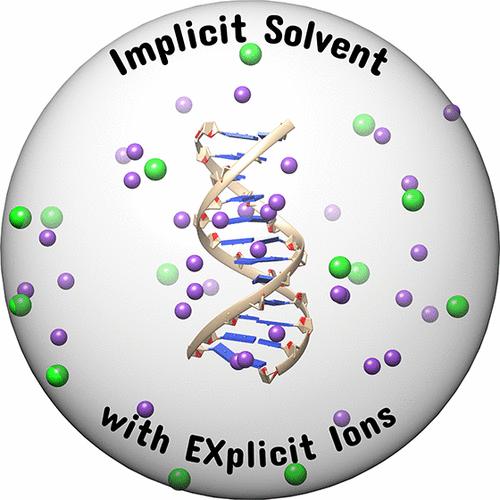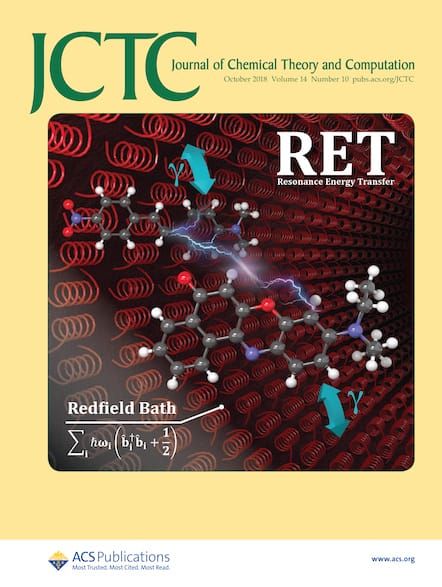Implicit Solvent with Explicit Ions Generalized Born Model in Molecular Dynamics: Application to DNA
IF 5.7
1区 化学
Q2 CHEMISTRY, PHYSICAL
引用次数: 0
Abstract
The ion atmosphere surrounding highly charged biomolecules, such as nucleic acids, is crucial for their dynamics, structure, and interactions. Here, we develop an approach for the explicit treatment of ions within an implicit solvent framework suitable for atomistic simulations of biomolecules. The proposed implicit solvent/explicit ions model, GBION, is based on a modified generalized Born (GB) model; it includes separate, modified GB terms for solute–ion and ion–ion interactions. The model is implemented in the AMBER package (version 24), and its performance is thoroughly investigated in atomistic molecular dynamics (MD) simulations of double-stranded DNA on a microsecond time scale. The aggregate characteristics of monovalent (Na+ and K+) and trivalent (Cobalt Hexammine, CoHex3+) counterion distributions around double-stranded DNA predicted by the model are in reasonable agreement with the experiment (where available), all-atom explicit water MD simulations, and the expectation from the Manning condensation theory. The radial distributions of monovalent cations around DNA are reasonably close to the ones obtained using the explicit water model: expressed in units of energy, the maximum deviations of local ion concentrations from the explicit solvent reference are within 1 kBT, comparable to the corresponding deviations expected between different established explicit water models. The proposed GBION model is able to simulate DNA fragments in a large volume of solvent with explicit ions with little additional computational overhead compared with the fully implicit GB treatment of ions. Ions simulated using the developed model explore conformational space at least 2 orders of magnitude faster than in the explicit solvent. These advantages allowed us to observe and explore an unexpected “stacking” mode of DNA condensation in the presence of trivalent counterions (CoHex3+) that was revealed by recent experiments.

分子动力学中的隐式溶剂与显式离子广义博恩模型:应用于 DNA
核酸等高电荷生物大分子周围的离子环境对其动力学、结构和相互作用至关重要。在此,我们开发了一种在适合生物大分子原子模拟的隐式溶剂框架内显式处理离子的方法。所提出的隐式溶剂/显式离子模型 GBION 基于改进的广义玻恩(GB)模型;它包括单独的、改进的溶质-离子和离子-离子相互作用 GB 项。该模型在 AMBER 软件包(第 24 版)中实现,并在双链 DNA 的微秒级原子分子动力学(MD)模拟中对其性能进行了深入研究。该模型预测的双链 DNA 周围一价(Na+ 和 K+)和三价(六价钴,CoHex3+)反离子分布的集合特征与实验(如有)、全原子显式水 MD 模拟以及曼宁凝聚理论的预期结果基本一致。DNA 周围单价阳离子的径向分布与利用显式水模型得到的分布相当接近:以能量单位表示,局部离子浓度与显式溶剂参考值的最大偏差在 1 kBT 以内,与不同已建立的显式水模型之间的预期偏差相当。与完全隐式的离子 GB 处理相比,所提出的 GBION 模型能够用显式离子模拟大体积溶剂中的 DNA 片段,几乎不增加计算开销。使用所开发模型模拟的离子探索构象空间的速度比在显式溶剂中至少快 2 个数量级。这些优势使我们能够观察和探索三价反离子(CoHex3+)存在时 DNA 的一种意想不到的 "堆叠 "缩合模式,这种模式是最近的实验所揭示的。
本文章由计算机程序翻译,如有差异,请以英文原文为准。
求助全文
约1分钟内获得全文
求助全文
来源期刊

Journal of Chemical Theory and Computation
化学-物理:原子、分子和化学物理
CiteScore
9.90
自引率
16.40%
发文量
568
审稿时长
1 months
期刊介绍:
The Journal of Chemical Theory and Computation invites new and original contributions with the understanding that, if accepted, they will not be published elsewhere. Papers reporting new theories, methodology, and/or important applications in quantum electronic structure, molecular dynamics, and statistical mechanics are appropriate for submission to this Journal. Specific topics include advances in or applications of ab initio quantum mechanics, density functional theory, design and properties of new materials, surface science, Monte Carlo simulations, solvation models, QM/MM calculations, biomolecular structure prediction, and molecular dynamics in the broadest sense including gas-phase dynamics, ab initio dynamics, biomolecular dynamics, and protein folding. The Journal does not consider papers that are straightforward applications of known methods including DFT and molecular dynamics. The Journal favors submissions that include advances in theory or methodology with applications to compelling problems.
 求助内容:
求助内容: 应助结果提醒方式:
应助结果提醒方式:


